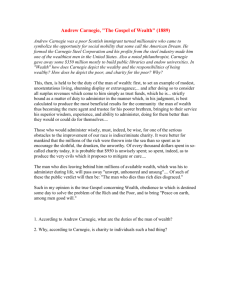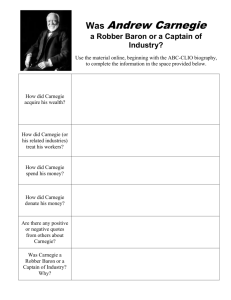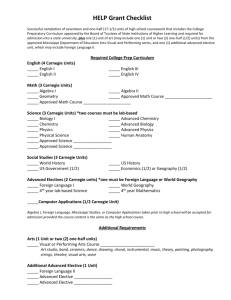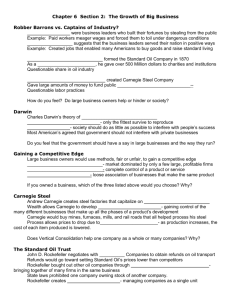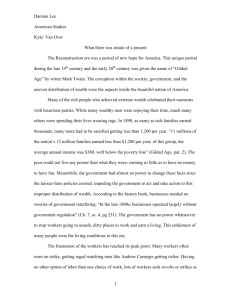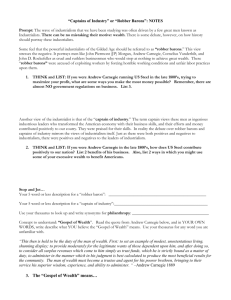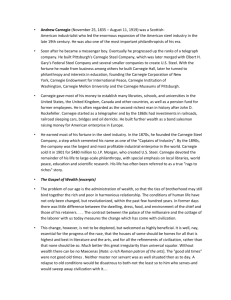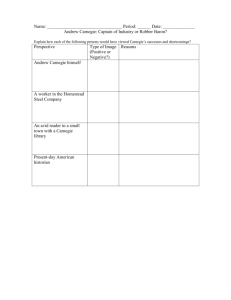Teacher Guide to Student Worksheet 1 – Primary Source Analysis
advertisement
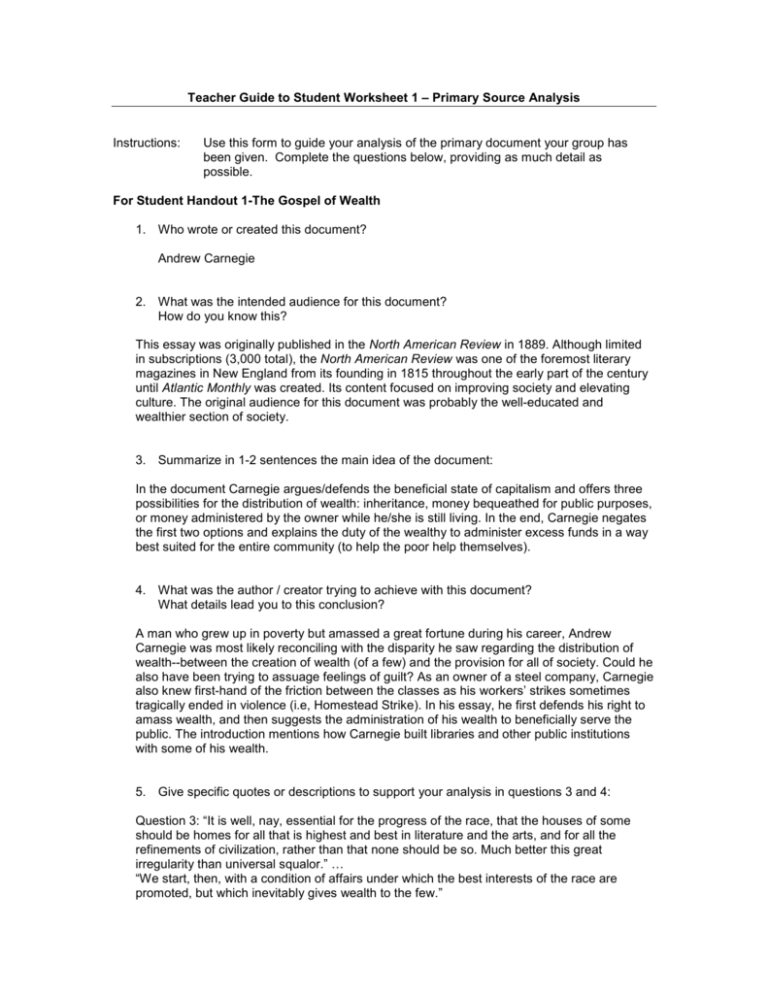
Teacher Guide to Student Worksheet 1 – Primary Source Analysis Instructions: Use this form to guide your analysis of the primary document your group has been given. Complete the questions below, providing as much detail as possible. For Student Handout 1-The Gospel of Wealth 1. Who wrote or created this document? Andrew Carnegie 2. What was the intended audience for this document? How do you know this? This essay was originally published in the North American Review in 1889. Although limited in subscriptions (3,000 total), the North American Review was one of the foremost literary magazines in New England from its founding in 1815 throughout the early part of the century until Atlantic Monthly was created. Its content focused on improving society and elevating culture. The original audience for this document was probably the well-educated and wealthier section of society. 3. Summarize in 1-2 sentences the main idea of the document: In the document Carnegie argues/defends the beneficial state of capitalism and offers three possibilities for the distribution of wealth: inheritance, money bequeathed for public purposes, or money administered by the owner while he/she is still living. In the end, Carnegie negates the first two options and explains the duty of the wealthy to administer excess funds in a way best suited for the entire community (to help the poor help themselves). 4. What was the author / creator trying to achieve with this document? What details lead you to this conclusion? A man who grew up in poverty but amassed a great fortune during his career, Andrew Carnegie was most likely reconciling with the disparity he saw regarding the distribution of wealth--between the creation of wealth (of a few) and the provision for all of society. Could he also have been trying to assuage feelings of guilt? As an owner of a steel company, Carnegie also knew first-hand of the friction between the classes as his workers’ strikes sometimes tragically ended in violence (i.e, Homestead Strike). In his essay, he first defends his right to amass wealth, and then suggests the administration of his wealth to beneficially serve the public. The introduction mentions how Carnegie built libraries and other public institutions with some of his wealth. 5. Give specific quotes or descriptions to support your analysis in questions 3 and 4: Question 3: “It is well, nay, essential for the progress of the race, that the houses of some should be homes for all that is highest and best in literature and the arts, and for all the refinements of civilization, rather than that none should be so. Much better this great irregularity than universal squalor.” … “We start, then, with a condition of affairs under which the best interests of the race are promoted, but which inevitably gives wealth to the few.” “This, then, is held to be the duty of the man of Wealth: …to provide moderately for the legitimate wants of those dependent upon him; and after doing so to consider all surplus revenues which come to him simply as trust funds, which he is called upon to administer, and strictly bound as a matter of duty to administer in the manner which, in his judgment, is best calculated to produce the most beneficial result for the community…” Question 4: The first sentence shows what Carnegie views as “the problem of our age:” “The problem of our age is the administration of wealth, so that the ties of brotherhood may still bind together the rich and the poor in harmonious relationship.” 6. How might this document be different if it had been written for a different audience? Give specific details. There are occasions in this essay when Carnegie displays a bit of an elitist attitude. For example, at the end he says “…the man of wealth thus becoming the sole agent and trustee for his poorer brethren, bringing to their service his superior [emphasis mine] wisdom, experience, and ability to administer-doing for them better than they would or could for themselves.” If the lower-class read these words, it is doubtful they would sit well. 7. What aspects of this document might be relevant to current situations? The disparity between the rich and poor is still as much of an issue today as it was during Carnegie’s day. Many wealthy still follow Carnegie’s “gospel,” distributing their wealth among philanthropic institutes and charitable foundations. 8. What is your reaction to the points raised by the author / creator? Be open to various appropriate responses. Responses could vary. Students could be: ~thankful to Carnegie’s progressive ideas for his day (most people were simply keeping their wealth in their family through inheritance) and thankful for his considerable contributions to our society ~wary of the author’s ultimate intent (Was he ultimately arguing to preserve his power to make and distribute wealth?) ~offended by his sense of superiority 9. How could the author have made his point in a more effective fashion? In fact, he did. His actions followed his words, and he contributed an enormous sum to society creating approximately 3,000 public libraries in the United States as well as numerous educational institutes, museums, and the well-known prestigious performance venue in New York City, Carnegie Hall. His contributions also extended to society in his homeland of Scotland as well as a number of other countries around the world. For Student Handout 2-Progress and Poverty Excerpt 1. Who wrote or created this document? Henry George 2. What was the intended audience for this document? How do you know this? th This was part of a larger book widely distributed to the general public in the 19 century. (This is evident from its original format.) 3. Summarize in 1-2 sentences the main idea of the document: Henry George offers his solution to the poverty he sees along side “progress.” His solution includes: making land common property, taxing property, and abolishing all other taxes. 4. What was the author / creator trying to achieve with this document? What details lead you to this conclusion? He was seeking the logical economic law that made poverty always appear in tandem with “progress”, and offered a solution to this societal dilemma. He also recognizes that people may have a difficult time with his recommendation and seeks to show its ultimate practicality. 5. Give specific quotes or descriptions to support your analysis in questions 3 and 4: Question 3 and 4: Seeking solution to economic disparity: ”We have traced the unequal distribution of wealth which is the curse and menace of modern civilization to the institution of private property in land” Solution offered: “This, then, is the remedy for the unjust and unequal distribution of wealth apparent in modern civilization, and for all the evils which flow from it: We must make land common property.” “It is not necessary to confiscate land; it is only necessary to confiscate rent.” “To abolish all taxation save that upon land values.” 6. How might this document be different if it had been written for a different audience? Give specific details. Henry George writes very methodically, logically, and thoroughly, outlining every step of his thought processes leading him to his final conclusions. If his audience was a group of professional economic theorists or if he had only a brief time to make his main point, his argument might be abbreviated. 7. What aspects of this document might be relevant to current situations? Students can draw comparisons to the economic disparity seen today, taxation currently employed by our government, etc. 8. What is your reaction to the points raised by the author / creator? Be open to various responses (positive or negative) that are well-articulated and thought out. 9. How could the author have made his point in a more effective fashion? He effectively argues his solution. Perhaps taking his argument and making it tangible would be an effective next step. He could create an experimental community in which his ideas were implemented on a small scale to show its desirable effect. [Additional student ideas and responses are acceptable here as well.] For Student Handout 3-Joseph Fels, “A Letter to Andrew Carnegie” 1. Who wrote or created this document? Joseph Fels 2. What was the intended audience for this document? How do you know this? Andrew Carnegie. This was a letter written to Mr. Carnegie. 3. Summarize in 1-2 sentences the main idea of the document: Andrew Carnegie has made a donation of ten million dollars to an international peace fund. Joseph Fels is expressing his opinion that it will not be effective because it will not get to the real root of warfare, which, as he sees it, is economic necessity for nations. Fels discusses the fundamental importance of free trade, and his desire to see private land monopolies abolished in order to secure peace. 4. What was the author / creator trying to achieve with this document? What details lead you to this conclusion? Fels was expressing his opinion to Carnegie about the importance of opening up unused private land with natural resources to stimulate domestic markets by employing the underand un-employed. Since Carnegie owned land laden with natural resources, Fels was suggesting to Carnegie that this would be a more effective way to secure peace and economic stability than his large donation to the international peace fund. 5. Give specific quotes or descriptions to support your analysis in questions 3 and 4: Question 3: War as economic necessity: “Aggressive warfare is always the result of what appears to be an economic necessity.” Importance of free trade: “If conditions of absolute free trade had prevailed, Russia would no more have felt the lack of an accessible seaport than does the State of Ohio.” Desire of Fels to see funds used to abolish land monopolies: “Will the Carnegie Fund be used to any extent in abolishing land monopoly, thus checking any possible repetition of successful appeals to commercial cupidity in support of land-grabbing schemes abroad?” Question 4: Creating economic markets at home to secure peace: “The unemployed and partially employed population and the underpaid workers form a potential market far greater than any war of conquest could secure.” 6. How might this document be different if it had been written for a different audience? Give specific details. This was a private letter written to Andrew Carnegie—one of the wealthiest men in our nation. Fels shows a desire to create a more balanced distribution of wealth, and his frustration with the “business” methods/”land-grabbing schemes” of the wealthy, including Carnegie, is evident in the tone of his letter. His last line is particularly cutting, “A gift of ten million to secure relief from malaria in a swampy district, which could not be used to secure the draining of the swamps, or the destruction of the mosquitoes would be just as effective as your peace donation.” With a different audience perhaps the tone of the message would be less biting and more objective. 7. What aspects of this document might be relevant to current situations? [This question is open to student interpretation of current political affairs--a student might take a look at the motivation of the war in Iraq, for instance.] 8. What is your reaction to the points raised by the author / creator? [Allow for various student responses. Expression of similar or differing opinion--as long as it is well expressed and reasoned--is welcomed here.] 9. How could the author have made his point in a more effective fashion? Response example: Perhaps his appeal could have be made without the final biting, cynical remark. His beginning of his letter is better in tone than the ending.

